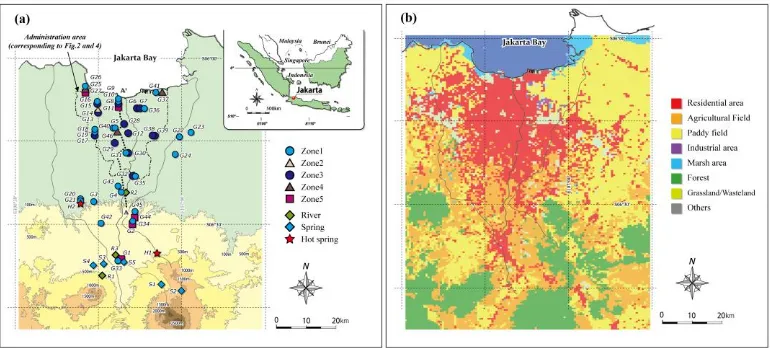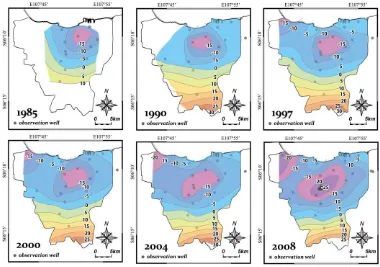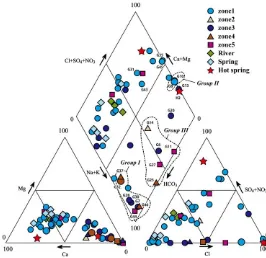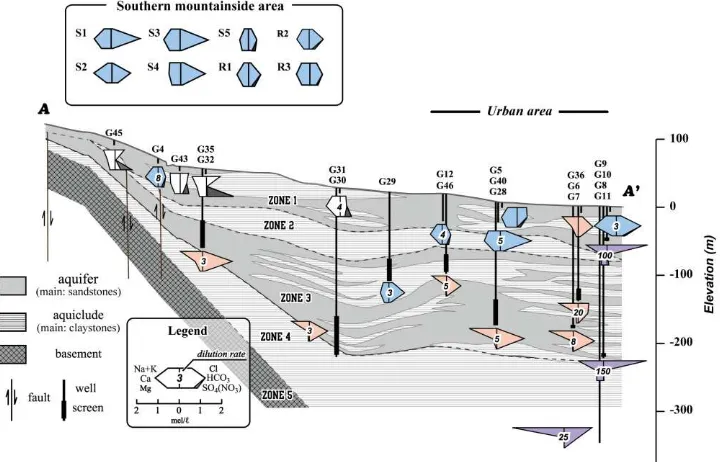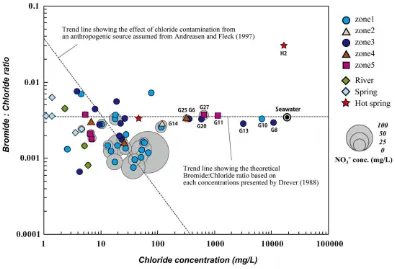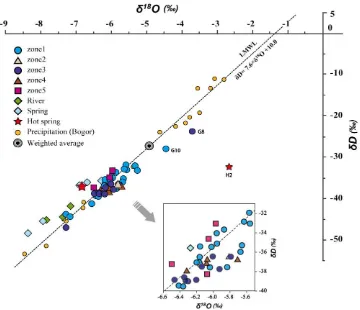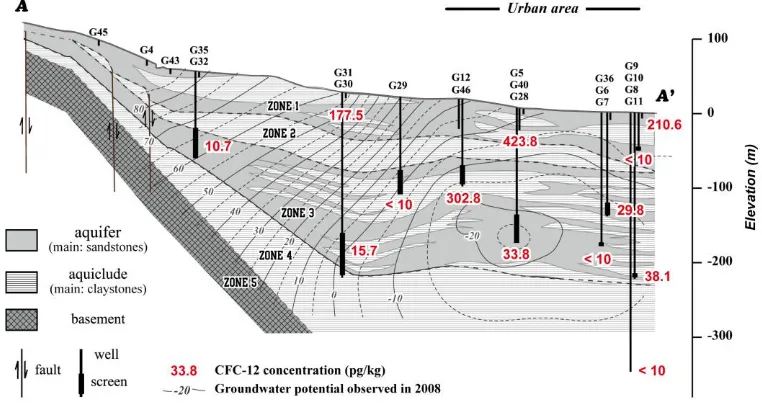69
GROUNDWATER CHARACTERISTICS IN JAKARTA AREA,
INDONESIA
Makoto Kagabu, Robert M. Delinom, Rachmat Fajar Lubis, Jun Shimada and
Makoto Taniguchi
ABSTRACT In the Jakarta area (Indonesia), excessive groundwater pumping due to the rapidly increasing population has caused groundwater-related problems such as brackish water contamination in coastal areas and land subsidence. In this study, we adopted multiple hydrogeochemical techniques to understand groundwater characteristic in the Jakarta area. Although almost all groundwater existing in the Jakarta basin is recharged at similar elevations, the water quality and apparent residence time demonstrates a clear difference between the shallow and deep aquifers.
Naskah masuk : 12 Oktober 2010 Naskah diterima : 14 Desember 2010
Makoto Kagabu Kumamoto University
Email : m.kagabu@es.sci.kumamoto-u.ac.jp
Robert M. Delinom
Research Center for Geotechnology, Indonesian Institute of Sciences, Bandung 40135
Email : rm.delinom@geotek.or.id
Rachmat Fajar Lubis
Research Center for Geotechnology, Indonesian Institute of Sciences, Bandung 40135
Email : fajarlubis@geotek.lipi.go.id ratios and chlorofluorocarbon (CFC)-12 analysis.
Keywords :groundwater hydrogeochemistry, excessive groundwater pumping, chlorofluoro carbon (CFC), Jakarta, Indonesia
ABSTRAKDi Jakarta, Indonesia, pemompaan airtanah yang terus menerus karena penambahan jumlah penduduk telah menyebabkan terjadinya beberapa masalah yang berhubungan dengan sumberdaya air, seperti adanya kontaminasi air payau di sekitar pantai dan penurunan muka tanah. Dalam penelitian ini, telah digunakan berbagai teknik kimia airtanah untuk mengetahui karakteristik dari airtanah di Daerah Jakarta. Meskipun hampir semua airtanah di Jakarta diresapkan pada ketinggian yang sama, kualitas air dan waktu tinggal memperlihatkan perbedaan yang jelas antara akifer dangkal dan akifer dalam. Karena adanya penurunan airtanah potesial yang cepat di daerah perkotaan, ditemukan bahwa intrusi airlaut dalam airtanah bebas dan adanya percampuran antara airtanah bebas dan tertekan, kesimpulan ini dikonfirmasi oleh ion utama, rasio Br−:Cl- dan analisis chlorofluoro- carbon (CFC)-12.
70
Figure 1 Maps showing (a) study area and sampling locations and (b) the land use divided into eight components. A cross line (A-A’) in Fig. 1a corresponds to the cross sections in Figs. 4 and 7.
INTRODUCTION
Subsurface environmental problems, such as land subsidence due to excessive groundwater abstraction and groundwater contamination, have occurred consecutively in large Asian cities (Foster and Chilton, 2003) with some time lag between each city. Most of these growing Asian mega-cities are located in coastal areas (Jiang et al., 2001) where basement geologies are composed of quaternary marine or fluvial unconsolidated deposits. Jakarta, the capital city of Indonesia, is one of the cities that suffer from groundwater related problems.Researchers have recently conducted hydrogeochemical studies of the Jakarta Groundwater Basin. Delinom et al. (2009) classified regional groundwater into hydrochemical groups on the basis of major ion chemistry by using Stiff diagrams. Umezawa et al. (2008) and Onodera et al. (2008) showed nitrate contamination in agricultural fields and mentioned the possibility of seawater intrusion into groundwater in coastal areas. Lubis et al. (2008) identified recharge and discharge areas by groundwater temperature profile measurements in deep observation wells. However, an integrated study that employs multiple hydrogeochemical techniques has not yet been performed in the Jakarta groundwater basin.
STUDY AREA
The Java Sea borders Jakarta, the capital city of the Republic of Indonesia, to the north (Fig. 1a). The province of Jakarta (DKI Jakarta;
6°00'-6°20″ S, 106°42'-107°00″ E) has a surface area of approximately 652 km2 and a humid tropical climate that is significantly influenced by monsoon winds. The long-term mean annual rainfall in this city ranges between 1,500 and 2,500 mm/year, with a dry season (<100 mm/month) that lasts 7–8 months in coastal areas, 2–4 months at elevations of 30–50 m above sea level (asl), and less at higher elevations. Peak rainfall usually occurs throughout the region in January, while the least rainfall occurs between June and August. The long-term mean monthly temperature ranges between 26°C and 28°C, and the mean annual air temperature is 27°C. The mean potential evapotranspiration for the Jakarta region is 1,606 mm/year (Tambunan, 2007).
71 Zones 2 and 4 are aquiclude layers composed of
claystone with sand infixes.
Zone 3 is a deep aquifer layer composed of sandstone with infixes of breccias and claystone. Zone 5 is the basement of the Jakarta Groundwater Basin, composed of impermeable rocks such as limestone and claystone.
The vertical cross section of the local Groundwater samples were collected from observation wells, production wells, and dug wells.
Temperature, pH, and electric conductivity (EC) of the water samples collected in this study were measured in the field by using a portable EC/pH meter (WM-22EP, TOA DKK, Japan). Samples
for stable isotope (δ18O and δD) and major ion
(Na+, K+, Ca2+, Mg2+, Cl−, NO3−, and SO42−)
analyses were collected in 100-mL polyethylene bottles at the hydrology laboratory of Kumamoto University.
We analyzed the major ions by ion chromatography (Compact IC 761, Metrohm, Switzerland) with the analytical error typically within 10%; the alkalinity titration could be substituted for the activity of HCO3−. Stable
isotope ratios and D/H ratios of water were determined by the CO2 equilibration method and
the chromium-reduction method, respectively, followed by analysis by using a Thermo Electron Delta S mass spectrometer (USA). Hydrogen and oxygen isotope ratios were expressed using δD the Vienna Standard Mean Ocean Water standard (V-SMOW; Craig, 1961). The analytical error
was ±0.1‰ for δ18O and ±1.0‰ for δD.
Groundwater samples for CFC analysis were collected in triplicate and stored in glass bottles sealed with metal lined caps (Busenberg and Plummer, 1992). We analyzed the CFCs by closed system purge and trap gas chromatography by using an electron capture detector (GC-8A, Shimadzu, Japan). Water samples for CFCs were analyzed in triplicate, and the values were reported only if the concentrations of at least two measurements were within 10% for concentrations above 100 pg/kg. Below 100 pg/kg concentrations, the values were reported only if at least two measurements were within 20 pg/kg of each other (Johnston et al., 1998). The analytical uncertainty associated with CFC analysis was less than 5%.
RESULTS
Groundwater potential
We obtained groundwater potential data from 30 observation wells in the study area for the period from 1985 (oldest) to the present. The spatial distribution of groundwater potential was estimated on the basis of the observation well data. Figure 2 shows the groundwater potential of the deep aquifer for the years 1985, 1990, 1997,
northwest of the city in 2008 when it was −25 m.
72
Figure 2 Historical change in the spatial distribution of groundwater potential. Unit of the potential is meters above sea level.
Major ions
Fig. 3 plots a Piper diagram, referring to the concentrations of hydrogeochemical components of groundwater samples which collected in this study. Figure 4 shows the distribution of the stiff diagram along a cross section that passed through the central Jakarta area (A-A’; Fig. 1a). The depth of the screen at each sampling point was projected to this cross section from the coast along the topographical profile.
In the Piper diagram of Fig. 3, samples collected from spring and river waters are of the Ca-HCO3
-type. Therefore, waters in upstream areas can be recognized as those with juvenile features; they are not much affected by human activities. Many shallow groundwaters (zones 1 and 2) are also of the Ca-HCO3-type. However, shallow
groundwater in the middle stream area possessed high NO3− concentrations, as shown in Fig. 4
(G31, G35, G43, and G45), especially those
within the areas of high agricultural activity, located between the urbanized and mountain areas (Fig. 1b). On the other hand, the deep groundwater (zones 3 to 5) was of the Na-HCO3
73 Figure 3 Piper diagram for the major ions.
this result may be due to the geological setting, including the local fault system (Delinom et al., 2009).
According to the results of the major ion analyses, Ca-HCO3-type groundwaters mainly
recharge the aquifer in the upstream area, and this water changes to the Na-HCO3 type as it
flows in the northern, deeper direction. This change can be explained by the cation exchange reaction (Na+ ↔ Ca2+) (Appelo and Postma, 2005). A similar tendency occurs in the groundwater flow system of the Osaka basin (Yamanaka et al., 2005).
Bromide:chloride ratio of groundwater in Jakarta
Bromide and chloride are particularly good indicators of seawater intrusion, because both these ions are chemically conserved in natural aqueous environments. Both ions also move freely in the subsurface. Similar Br−:Cl− ratios in groundwater and seawater indicate that seawater is a source of chloride. Dissimilar ratios in
groundwater and seawater indicate that chloride is derived, at least in part, from another chloride source (Fetter, 1993).
We determined the nitrogen concentrations in order to indicate the possible presence of another chloride source in the groundwater. Nitrate and chloride commonly occur together in groundwater contaminated by sewage effluent. Potential sources of sewage contamination of the groundwater in the study area include residential septic systems and public sewer lines. Contamination of groundwater by nitrate from fertilizers might also result in elevated chloride concentrations (Richter and Kreitler, 1993).
74
Figure 4 Vertical distribution of the stiff diagram along a cross sections shown in Fig. 1a.
This trend line represents the native groundwater affected by an anthropogenic chloride source. Also plotted in the figure, the NO3− concentration
(mg/L) shows the potential contamination. The Br−:Cl− ratios were similar to the seawater ratio with a high chloride concentration in samples collected from the coastal area (G6, G8, G10, G11, G13, G25, and G27). Since these samples show the Na-HCO3 to the Na-Cl type
(Figs. 3 and 5), the seawater was the primary source of chloride.
Shallow groundwater samples were scattered along the anthropogenic line with high NO3−
concentrations and low Br−:Cl− ratios. These results support the nitrate contamination caused by fertilizers in dry fields, reported by Umezawa et al. (2008).
Stable isotopes
Figure 6 shows the relationship between δ18O
and δD. This figure displays the local meteoric water line (LMWL), which is generated from the precipitation in Bogor, the southern part of the study area. The LMWL is expressed as δD = 7.6δ18O + 10, based on the 20 times term
sampling of local precipitation from November 2006 to October 2007.
Spring and river water samples located in the southern mountainside area are mostly plotted above the LMWL and relatively depleted positions, implying that these waters were recharged at relatively higher elevations, i.e., mountain areas. On the other hand, despite being collected from different depths, 76.1% of the groundwater samples in the study area had stable isotopes that could be plotted within a narrow range (−5.6 to −6.5‰ δ18O and −30 to −40‰
75 Figure 5 Relationship between the Br−:Cl− ratios and the Cl− and NO3− concentrations.
CFC-12 concentration
CFCs are useful tools for tracing and dating post-1945 groundwater (Busenberg and Plummer, 1992; Plummer et al., 2000; Plummer et al., 2001). We, therefore, employed CFCs as a marker for young groundwater, because the release of CFCs into the atmosphere only started after the 1940s (USGS, 2010). Consequently, if groundwater possesses some dissolved CFCs, it was recharged after the 1940s. In this study, we used CFC-12 because of its stability in the subsurface environment (Plummer et al., 1998). Figure 7 shows the distribution of CFC-12 (mg/L) along the cross section. Since the shallow groundwater (Zone 1) showed a large CFC-12 concentration, it can be considered modern (young) and was recharged after the 1940s. On the other hand, the deep groundwater (zones 3 and 5) had low concentrations, and some wells possessed concentrations below the detection
limit. However, because some deep groundwater samples collected from under the urban area (G6, G8, and G28) somehow possessed CFC-12 concentrations, the shallow (young) groundwater and/or present seawater component might be introduced into the deeper aquifer. The driving force of this forced groundwater movement is the excessive groundwater pumping in the central urban area, corresponding to the rapid urbanization.
DISCUSSION
76
Figure 6 Relationship between δ18O and δD in all water samples.
Although the river water and many shallow groundwater samples displayed Ca-HCO3-type
water chemistry, the shallow groundwater in the southern area’s dry field showed clear nitrate contamination, which is mostly due to artificial fertilizers, including agrochemicals, from agricultural activities. Umezawa et al. (2008) confirmed via stable N and O isotopes in NO3−
that the nitrate contamination in this area is caused by the application of fertilizers and by household effluents. According to these results, we can assume that most parts of the Cl− and SO42− proportions in the Piper diagram are due to
the agricultural activities utilizing excessive fertilizers, agrochemicals, and, to a lesser degree, household effluents.
The Br−:Cl− ratios versus the chloride and NO3−
concentrations (Fig. 5) demonstrated that the shallow groundwater deviated from the Br/Cl’s seawater mixing line with a relatively high NO3−
77 Figure 7 Vertical distribution of CFC-12 concentrations along a cross sections shown in Fig. 1a. Hemisphere’s atmosphere, which is
contaminated, we could not evaluate the exact residence time of the groundwater. However, since CFC-12 was detected in the shallow groundwater, it was recharged after the 1940s.
Deep groundwater had Na-HCO3-type water
chemistry, suggesting that the chemical evolution during the groundwater flow process changed from the original Ca-HCO3-type shallow water
chemistry, indicating that it had a relatively long residence time than the shallower groundwater. This result is consistent with the CFC-12 contents; CFC-12 concentration in the deep groundwater was near or lower than the detection limit, implying that it was at least older than the 1940s. However, we found somewhat high CFC-12 concentrations in some deep groundwater samples, mostly collected under the well developed urban area (G6, G8, and G28) where the groundwater depression zone is located (Fig. 7), implying that the young groundwater component intruded from the shallow aquifer or that seawater was present due to excessive pumping of groundwater in the urban area.
CONCLUSION
We studied the groundwater characteristics in the Jakarta area by hydrogeochemical techniques such as stable isotopes (δD and δ18O), water
chemistry by major ions, Br−:Cl− ratio, and CFC analyses.
In the Jakarta area, although hydrogeochemical characteristics showed various water chemistries depending on the aquifer depths, almost all (shallow and deep) groundwater samples recharged at similar elevations. In the shallow groundwater, groundwater samples were characterized by Ca-HCO3-type water chemistry,
but some groundwater samples collected near dry agricultural fields displayed nitrate contamination related to the agricultural activities. This finding was supported by both stable N and O isotope content in NO3−
(Umezawa et al., 2008) and the Br−:Cl− ratios in the groundwater samples. On the other hand, the deep groundwater samples had Na-HCO3-type
78
was affected by seawater intrusion, caused by over pumping in the urban area. This result was also supported by the Br−:Cl− ratio, shown along the mixing line with sea water.
The difference in hydrogeochemistry between shallow and deep groundwater samples implied a difference in the relative residence times of their respective groundwaters, and this result was supported by the results of the CFC-12 analyses. Concentrations of CFC-12 were higher (and, groundwater potential depression zone is located, suggesting that the recent shallow, younger groundwater intruded into the deeper aquifer because of excessive groundwater pumping, corresponding with rapid urbanization.
This study clearly reveals the groundwater characteristics of the Jakarta area by integrating several hydrogeochemical components. Since the excessive groundwater pumping disturbs the subsurface environment, including the groundwater mixing of the shallow and deep aquifers and seawater intrusion in the coastal area, it is necessary to construct frameworks for the management of local groundwater resources, including pumping regulations and effective artificial recharge for the groundwater aquifer.
ACKNOWLEDGMENT
We thank the staff of the Indonesia Institute of Sciences (LIPI) for sampling. This research was funded by the project “Human Impacts on Urban Subsurface Environment,” Research Institute for Humanity and Nature (RIHN).
REFERENCES
Andreasen D. C., Fleck W. B. (1997) Use of Bromide:Chloride Ratios to Differentiate Potential Sources of Chloride in a Shallow, Unconfined Aquifer Affected by Brackish-Water Intrusion. Hydrogeology Journal, 5, 2, 17–26.
Appelo C. A. J., Postma D. (2005) Ion exchange. In: Appelo C.A.J., Postma D., editors. Geochemistry, groundwater and pollution. AA Balkema Publishers, Leiden, 241–309. Busenberg E., Plummer L. N. (1992) Use of
chlorofluorocarbons (CCl3F and CCl2F2)
as hydrologic tracers and age-dating tools: the alluvium and terrace system of central Oklahoma. Water Resour. Res., 28, 2257– 2283.
Craig H. (1961) Isotope variations in meteoric waters. Science, 133, 1702-1703.
Delinom R. M. (2008) Groundwater management issues in the Greater Jakarta area, Indonesia. Proceedings of International Workshop on Integrated Watershed Management for Sustainable Water Use in h Humid Tropical Region, JSPS-DGHE Joint Research Project, 8, 40–54.
Delinom R. M., Delinom A. A., Hasanuddin Z. A., Makoto T., Dadan S., Rachmat F. L., Eko Y. (2009) The contribution of human activities to subsurface environment degradation in Greater Jakarta Area, Indonesia. Science of the Total Environment, 407, 3129–3141. doi:10.1016/j.scitotenv.2008.10.003. Drever J. I. (1988) The Geochemistry of Natural
Waters, second ed. Prentice Hall, Inc. Fachri M., Djuhaeni, L. M. Hutasoit and A. M.
Ramdhan (2003) Stratigraphy and hydrostratigraphy in Jakarta groundwater basin (in Indonesian). Bull Geol Bandung Instit Technol, 34, 169–189.
Fetter C. W. (1993) Contaminant hydrogeology. New York, Macmillan Publishing Co., 458p.
Foster S. S. D., Chlton P. J. (2003) Groundwater: the process and global significance of aquifer degradation. Philosophical Transactions of the Royal Society of London Series B-Biological Sciences, 358, 1957–1972.
79 Jiang Y., Kirkman H., and Hua A. (2001)
Megacity development: managing impacts on marine environments. Ocean and Coastal Management, 44, 293–318. Lubis R. F., Sakura Y., and Delinom R. M.
(2008) Groundwater recharge and discharge processes in the Jakarta groundwater basin, Indonesia. Hydrogeology Journal, 16, 927–938. Onodera S., Saito M., Sawano M., Hosono T.,
Taniguchi M., Shimada J., Umezawa Y., Lubis R. F., Buapeng S., and Delinom R. (2008) Effects of intensive urbanization on the intrusion of shallow groundwater into deep groundwater: Examples from Bangkok and Jakarta. Science of the Total Environment, 404, 401–410.
Richter B. C., Kreitler C. W. (1993) Geochemical techniques for identifying sources of ground-water salinization. Boca Raton, FL, C. K. Smoley, 258p.
Tambunan M. P. (2007) Flooding area in the Jakarta province on February 2 to 4 2007. Proceedings of Asian Association on Remote Sensing (ACRS) 2007.
Umezawa Y., Hosono T., Onodera S., Siringan F., Buapeng S., Delinom R., Yoshimizu C., Tayasu I., Nagata T., and Taniguchi M. (2008) The source and mechanisms controlling nitrate and ammonium contaminations in groundwater at developing Asian-Mega cities, Metro Manila, Bangkok and Jakarta. Science of the Total Environment, 407, 3219–3231. Yamanaka M., Nakano T., and Tase N. (2005)
